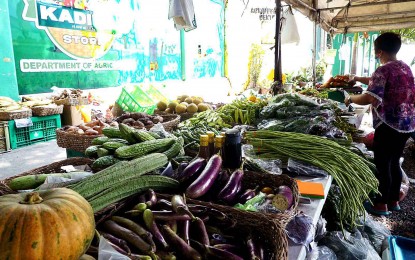
SUBDUED FOOD INFLATION. A scene for the produce section of a Kadiwa store in Diliman, Quezon City taken on April 25, 2023. February 2024 inflation in the Mimaropa region was moderated substantially by the hefty production of vegetables and other crops, as well as the higher output of meat. (PNA photo by Ben Briones)
CALAPAN CITY, Oriental Mindoro – Inflation in the Mimaropa region is expected to continue on a downward slope this month as food stocks increase due to the ongoing harvest season.
The National Economic and Development Authority’s (NEDA) top economist in Mimaropa made this projection following the release of the region’s latest inflation data showing food inflation dropped to 3.1 percent in February 2024 compared to its 11.2 percent level in the same month last year.
In an interview on Friday, Emerson Kim Lineses, chief economic development specialist at NEDA-Mimaropa, said price pressures caused by costlier rice and a recent outbreak of African swine fever (ASF) have been offset by the hefty production of other food groups.
He said while rice inflation surged to 15.8 percent last month, this was ultimately blunted by a drop in the prices of vegetables, meat, fish and sugar, among others.
In fact, several heavily-weighted food items registered negative inflation in February.
Inflation in the vegetables, tubers, plantains, cooking bananas and legumes cluster fell to negative 9.8 percent last month, while the sugar, confectionary and desserts cluster dropped to negative 5.8 percent.
Meat and fish also registered negative inflation, although their decline was more subdued.
“Per latest data, inflationary measures by (the) government such as assistance to MSMEs (micro, small and medium enterprises), the agri-fishery sector, and social welfare assistance, inflation can be controlled in the following months. However, the effects of El Niño in the region remain to be seen,” Lineses told the Philippine News Agency.
So far, El Niño’s impact in the five-province region has been mixed, with Occidental Mindoro experiencing a dry spell that is proving ruinous to crops while food production in its neighboring provinces is far less affected.
The NEDA official said ASF outbreaks in multiple piggeries across the region have had the unexpected effect of stimulating higher production of cattle and goat, thus contributing to a rise in the overall food production here.
Meanwhile, Lineses said a modest decline in the purchasing power of the peso (PPP) in February 2024 compared to the same period in the previous year is not alarming, and this trend can easily reverse as long as food production continues on its positive path and tourist arrivals continue to grow.
The PPP in Mimaropa slid slightly to PHP0.76 last month compared to PHP0.79 in February 2023.
Lineses underscored the importance of the region’s burgeoning tourism sector that is triggering healthy competition in the hospitality industry, which in turn, contributes to the softening of overall inflation. (PNA)
